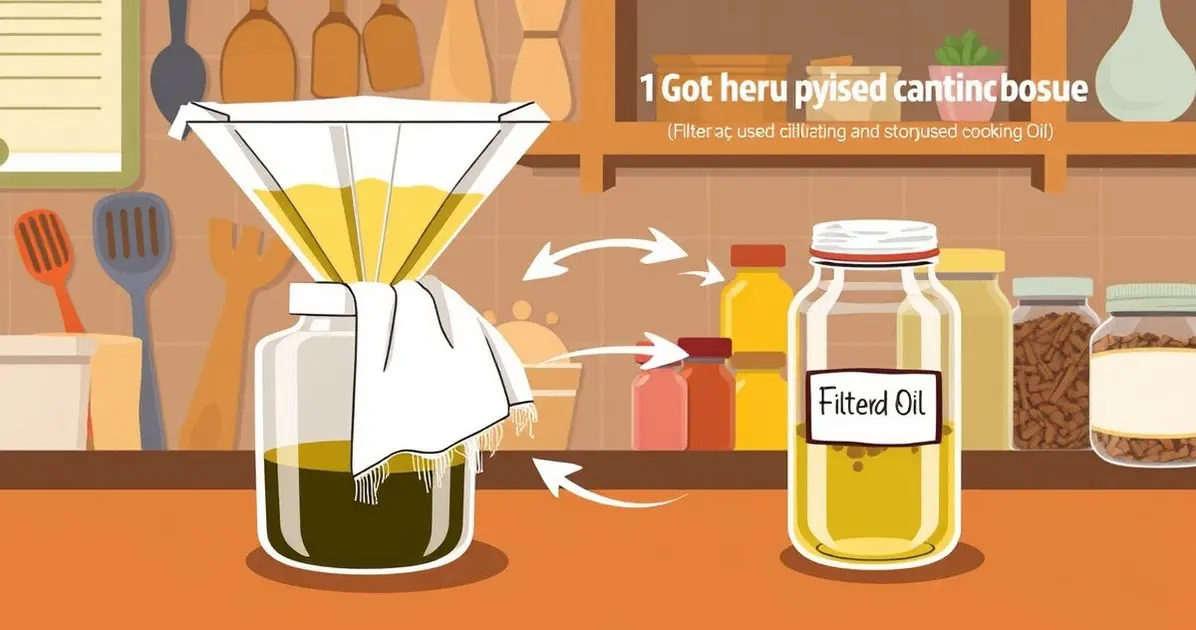Reusing cooking oil is a common practice in kitchens around the world. While it can save money and reduce waste, it’s essential to understand the safety and quality aspects before doing so.
Can cooking oil be reused

Yes, cooking oil can be reused, but it must be done carefully. After frying, allow the oil to cool, filter out food particles, and store it in a clean, airtight container. Ensure the oil hasn’t developed off-flavors or odors, and limit reuse to a few times for the best quality.
Benefits of Reusing Cooking Oil
Reusing cooking oil can offer several benefits, making it an appealing option for many home cooks. Here are some of the key advantages of reusing cooking oil:
1. Cost Savings: One of the most significant benefits of reusing cooking oil is the potential for cost savings. Cooking oil can be expensive, especially for high-quality varieties. By reusing oil, you can stretch your budget further and reduce the frequency of purchasing new oil.
2. Reducing Waste: Reusing cooking oil contributes to environmentally friendly practices by minimizing waste. Instead of discarding used oil after a single use, you can give it a second life, which helps reduce the amount of oil that ends up in landfills or drains.
3. Flavor Enhancement: In some cases, reused cooking oil can enhance the flavor of dishes. For example, oil that has been used to fry flavorful foods can impart a subtle taste to subsequent dishes, adding depth to your culinary creations.
4. Convenience: Having a supply of reused cooking oil on hand can be convenient for quick cooking tasks. If you frequently fry foods, having a ready supply of oil can save time and effort in the kitchen, allowing for quicker meal preparation.
5. Versatility: Reused cooking oil can be versatile, suitable for various cooking methods beyond frying. It can be used for sautéing, baking, or even in salad dressings, making it a practical ingredient to have in your kitchen.
In summary, reusing cooking oil presents several benefits, including cost savings, waste reduction, flavor enhancement, convenience, and versatility. By understanding these advantages, home cooks can make informed decisions about reusing oil while being mindful of safety and quality.
Drawbacks and Health Risks of Reusing Oil
While reusing cooking oil can offer several benefits, it is essential to be aware of the drawbacks and health risks associated with this practice. Here are some key concerns to consider:
1. Degradation of Oil Quality: Each time cooking oil is heated, it undergoes chemical changes that can degrade its quality. Repeated heating can lead to the formation of free radicals and harmful compounds that may pose health risks if consumed.
2. Risk of Irritation: Used cooking oil may contain food particles, which can promote bacterial growth and lead to irritation or infections when reused. Consuming oil with these impurities can negatively affect your digestive system and overall health.
3. Changes in Flavor: While reused oil can sometimes enhance flavor, it can also develop off-flavors over time. Cooking oil that has been used multiple times may impart undesirable tastes to your food, which can detract from the overall quality of your dishes.
4. Increased Risk of Inflammation: The degradation of oil can lead to the production of inflammatory compounds. Consuming these compounds may contribute to chronic inflammation in the body, potentially increasing the risk of various health issues over time.
5. Compatibility with Health Conditions: Individuals with specific health conditions, such as heart disease or high cholesterol, may want to avoid reusing cooking oil. The breakdown of oils can lead to the formation of trans fats and other unhealthy compounds that can exacerbate these conditions.
6. Reduced Nutritional Value: Repeated heating can diminish the nutritional value of cooking oil. Essential fatty acids and other beneficial compounds may break down during the cooking process, making reused oil less nutritious than fresh oil.
In conclusion, while reusing cooking oil can be economical and environmentally friendly, it is crucial to consider the potential drawbacks and health risks. By being aware of these concerns, you can make informed decisions about when and how to reuse cooking oil safely.

How to Properly Strain and Store Used Oil
Properly straining and storing used cooking oil is essential to maintain its quality and safety for reuse. Here are step-by-step instructions on how to do it effectively:
1. Allow the Oil to Cool: After cooking, let the oil cool down to a safe temperature. This helps prevent burns and makes it easier to handle. Waiting for the oil to cool also reduces the risk of steam and splattering during the straining process.
2. Prepare Your Straining Equipment: Gather the necessary equipment for straining the oil. You will need a fine mesh sieve, cheesecloth, or a coffee filter. If using cheesecloth, fold it several times to create a thicker barrier for filtering.
3. Set Up a Container: Place a clean, dry container or jar underneath the strainer to catch the strained oil. Make sure the container is suitable for storing oil and has a tight-sealing lid to prevent contamination.
4. Strain the Oil: Carefully pour the cooled oil through the strainer into the container. If using cheesecloth or a coffee filter, you may need to pour slowly to avoid overflow. This process will help remove food particles and impurities that can promote spoilage.
5. Allow for Additional Straining (if needed): If the oil appears cloudy or contains small particles after the first strain, consider straining it again through a clean filter or cheesecloth to ensure it is as clear as possible.
6. Store the Oil Properly: Once the oil is strained, seal the container tightly with a lid. Store the used oil in a cool, dark place, such as a pantry or cupboard, away from heat and light. If you plan to reuse the oil soon, refrigerating it can help extend its freshness.
7. Label the Container: It’s a good practice to label the container with the date of straining and the type of oil. This will help you keep track of its freshness and ensure that you use it within a safe timeframe.
By following these steps for properly straining and storing used cooking oil, you can maximize its quality and safety for future cooking, allowing you to enjoy the benefits of reuse while minimizing waste.
Signs of Spoilage in Cooking Oil
Recognizing the signs of spoilage in cooking oil is crucial for ensuring safety and maintaining the quality of your culinary creations. Here are the key indicators that your cooking oil may have gone bad:
1. Off Odor: One of the most noticeable signs of spoilage is a rancid or off smell. Fresh cooking oil should have a neutral or pleasant aroma. If the oil emits a strong, unpleasant odor, it is likely spoiled and should not be used.
2. Change in Color: Cooking oil that has gone bad may exhibit a noticeable change in color. For example, if clear oil appears cloudy or darkens significantly, it may indicate degradation. Each type of oil has its own typical color, so be aware of what it should look like when fresh.
3. Unusual Taste: If you taste the oil and find it has a bitter, sour, or otherwise strange flavor, it is a sign that it has spoiled. Fresh oil should have a clean, pleasant taste that complements your dishes.
4. Cloudiness or Sediment: While some oils may naturally appear cloudy when cold, excessive cloudiness or the presence of sediment can indicate spoilage. If the oil looks murky or has particles floating in it, it’s best to discard it.
5. Viscosity Changes: Spoiled oil may also exhibit changes in texture. If the oil feels thicker or has developed a sticky consistency, it may be a sign that it has degraded and is no longer safe to use.
6. Expiration Date: Always check the expiration date on the bottle. If the oil is past its expiration date, it’s safer to dispose of it, even if it appears fine. The expiration date provides a guideline for freshness.
By being vigilant and recognizing these signs of spoilage, you can ensure that you are using high-quality cooking oil in your dishes, which helps maintain both flavor and safety in your cooking. If you notice any of these indicators, it’s best to err on the side of caution and dispose of the oil.
Conclusion
In conclusion, understanding the reuse of cooking oil is essential for both economic and health-conscious cooking. While reusing oil can provide benefits such as cost savings and waste reduction, it is crucial to be aware of the potential drawbacks and health risks associated with this practice.
By recognizing the signs of spoilage, such as off odors, changes in color, and unusual tastes, you can ensure that you are using safe and high-quality oil in your culinary endeavors.
Properly straining and storing used oil is equally important to maintain its freshness and usability.
Ultimately, making informed decisions about when and how to reuse cooking oil can lead to a more sustainable kitchen while prioritizing your health and safety. By following the tips outlined in this guide, you can confidently incorporate reused cooking oil into your cooking practices, making environmentally conscious choices without compromising on quality.
FAQ – Frequently Asked Questions about Reusing Cooking Oil
Can cooking oil be reused?
Yes, cooking oil can be reused, but it is important to strain and store it properly to maintain quality and safety.
What are the benefits of reusing cooking oil?
Benefits include cost savings, reducing waste, and potentially enhancing the flavor of dishes.
What are the health risks associated with reusing cooking oil?
Health risks include the degradation of oil quality, irritation, and the formation of harmful compounds if the oil is reused too many times.
How can I tell if cooking oil has spoiled?
Signs of spoilage include off odors, changes in color, unusual taste, cloudiness, sediment, and being past the expiration date.
How should I properly strain and store used cooking oil?
Allow the oil to cool, strain it through a fine mesh sieve or cheesecloth, and store it in a clean, dry container in a cool, dark place.
What types of cooking oil are best for reuse?
Oils with higher smoke points, such as canola or peanut oil, are generally better suited for reuse compared to oils with lower smoke points.
See more
Discover plenty of easy and delicious recipes you can make at home, from hearty dinners to indulgent desserts and wholesome breakfasts.




